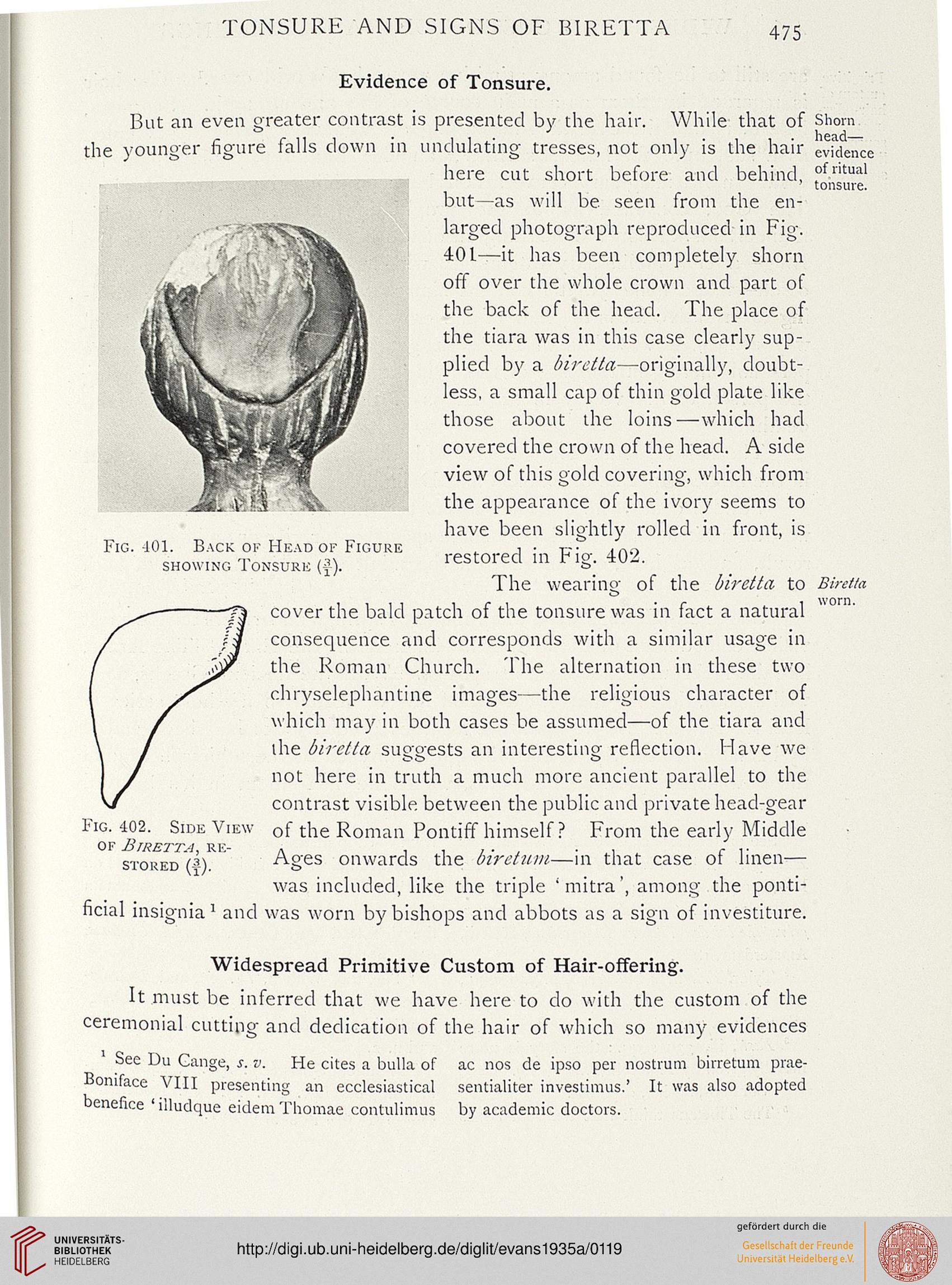TONSURE AND SIGNS OF BIRETTA
475
Evidence of Tonsure.
But an even greater, contrast is presented by the hair. While that of
the younger figure falls clown in undulating tresses, not only is the hair
here cut short before and behind,
but—as will be. seen from the en-
larged photograph reproduced- in Fig.
401—it has been completely shorn
off over the whole crown and part of
the back of the head. The place of
the tiara was in this case clearly sup-
plied by a biretta—originally, doubt-
less, a small cap of thin gold plate like
those about the loins—which had
covered the crown of the head. A side
view of this gold covering, which from
the appearance of the ivory seems to
have been slightly rolled in front, is
restored in F'ig. 402.
The wearing of the biretta to
cover the bald patch of the tonsure was in fact a natural
consequence and corresponds with a similar usage in
the Roman Church. The alternation in these two
chryselephantine images—the religious character of
which may in both cases be assumed—of the tiara and
the biretta suggests an interesting reflection. Have we
not here in truth a much more ancient parallel to the
contrast visible between the public and private head-gear
Fia402. Side View of the Roman Pontiff himself ? From the early Middle
Ages onwards the biretum—in that case of linen—
was included, like the triple 'mitra', among the ponti-
ficial insignia1 and was worn by bishops and abbots as a sign of investiture.
Shorn
head—
evidence
of ritual
tonsure.
Fig. 401. Back of Head of Figure
showing Tonsure (f).
Biretta
worn.
OF Btretta, re-
stored (}).
Widespread Primitive Custom of Hair-offering.
It must be inferred that we have here to do with the custom of the
ceremonial cutting and dedication of the hair of which so many evidences
See Du Cange, s. v. He cites a bulla of ac nos de ipso per nostrum birretum prae-
Boniface VIII presenting an ecclesiastical sentialiter investimus.' It was also adopted
benefice ■ illudque eidem Thomae contulimus by academic doctors.
475
Evidence of Tonsure.
But an even greater, contrast is presented by the hair. While that of
the younger figure falls clown in undulating tresses, not only is the hair
here cut short before and behind,
but—as will be. seen from the en-
larged photograph reproduced- in Fig.
401—it has been completely shorn
off over the whole crown and part of
the back of the head. The place of
the tiara was in this case clearly sup-
plied by a biretta—originally, doubt-
less, a small cap of thin gold plate like
those about the loins—which had
covered the crown of the head. A side
view of this gold covering, which from
the appearance of the ivory seems to
have been slightly rolled in front, is
restored in F'ig. 402.
The wearing of the biretta to
cover the bald patch of the tonsure was in fact a natural
consequence and corresponds with a similar usage in
the Roman Church. The alternation in these two
chryselephantine images—the religious character of
which may in both cases be assumed—of the tiara and
the biretta suggests an interesting reflection. Have we
not here in truth a much more ancient parallel to the
contrast visible between the public and private head-gear
Fia402. Side View of the Roman Pontiff himself ? From the early Middle
Ages onwards the biretum—in that case of linen—
was included, like the triple 'mitra', among the ponti-
ficial insignia1 and was worn by bishops and abbots as a sign of investiture.
Shorn
head—
evidence
of ritual
tonsure.
Fig. 401. Back of Head of Figure
showing Tonsure (f).
Biretta
worn.
OF Btretta, re-
stored (}).
Widespread Primitive Custom of Hair-offering.
It must be inferred that we have here to do with the custom of the
ceremonial cutting and dedication of the hair of which so many evidences
See Du Cange, s. v. He cites a bulla of ac nos de ipso per nostrum birretum prae-
Boniface VIII presenting an ecclesiastical sentialiter investimus.' It was also adopted
benefice ■ illudque eidem Thomae contulimus by academic doctors.





